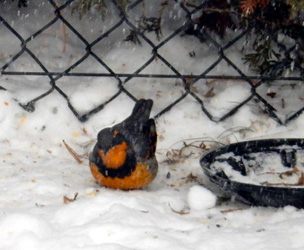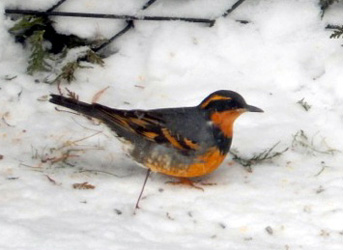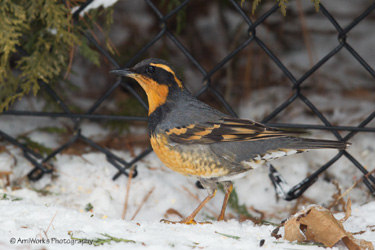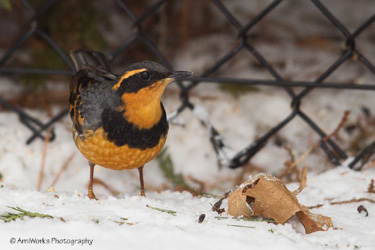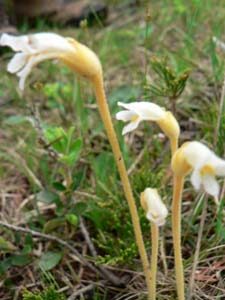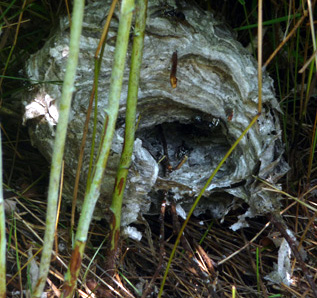December 2015 House Sparrow (Passer domesticus) Can it be a ” Threatened Invasive Species”

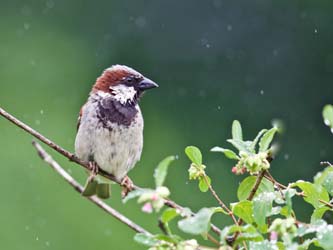

Photos taken by Arni Stinnissen on Mississaga St., Orillia
This cheerful, chirping sparrow, is not related to our other sparrows, such as Song, Savannah or White-throated sparrows.
It is really an Old World Sparrow, not native to North America.
Two centuries ago House Sparrows were familiar to residents of Eurasia and Africa.
It was introduced to North America after the 1850s.
It was first seen in the County in the late 1870s and multiplied rapidly.
In 1967, when the Birds of Simcoe County was published, it remained abundant.
|
Mike Burrell of Bird Studies Canada sent us this graph showing a pretty clear They report that there is a decrease in flock size, as well as locations. |
This charts the number of House Sparrows in the Orillia Xmas Bird counts since 1981. The trends are less obvious than in the |
In Ontario, Sudbury showed the largest proportional decline, but counts at Sault Ste. Marie and Thunder Bay also declined, despite being ports involved in grain shipping from the Prairies.
Anthony J. Erskine studied (and recently reported in the Canadian Field Naturalists) a serious decline in New Brunswick, which set in after 1970, continuing to the present. Now the species is rare to absent in much of the Maritimes, except around farms with livestock. Decline there, since 1970, probably approaches 90 per cent in most other areas of human settlement.
But the loss seems to be worldwide The British can be depended upon to keep records of their birds. The decline in the UK is a relatively recent phenomenon. From around 13 million pairs in the early 1970s,
numbers are now estimated to stand somewhere between 2.1 and 3.7 million: a 71 per cent drop.
In 1925, there were 2,600 house sparrows in Kensington Gardens; in 2000, there were just eight. Central London, along with the urban cores of Edinburgh and Glasgow, appears to be reporting near local extinction.
The house sparrow was declared the state bird of New Delhi in 2012, as part of a massive campaign to save the species and raise awareness.
“Because sparrows live side by side with people, the lack of sparrows in any place is of particular interest,” said head of Important Bird Areas Programme of BNHS and Indian Bird Conservation Network, Dr. Raju Kasambe.
“Only a citizen science programme with mass participation can help in collecting information about it on a pan-India scale,” said Dr. Kasambe. Sadly in India, we don’t have any historical statistical data because no one ever cared to count house sparrows. In China, the house sparrow was exterminated by about the end of the 1960s after being declared the number one crop pest.
This is what is happening. There is much speculation as to why.
Will we miss them if they die out? What should we do about it? Maybe we should do nothing.
November 2015 · SQUAWROOT (Conopholis americana)
PLANTS WITHOUT CHLOROPHYLL
In November Carol Strickland, Sue Deadman, Isobel Thorup and Fern Splichal were hiking with the Ganaraska Club in Awenda Park. They found a large patch of Squawroot ( about 40′ x40′ ) on both sides of the trail, in a deciduous forest, of beech (mostly diseased), oaks and some maples, high up on a cliff top, overlooking Georgian Bay.
Carole said that these strange little plants seemed to be parasitic – they seemed to be growing out of a piece of old limb, “in the case of the one I got down and dirty with”. The fruit had little purple berry-like things that when squished showed tiny seeds (tan-brown) very reminiscent of figs. The plants themselves resembled pine cones whose scales had partially opened and which harboured the fruit.
An internet search shows that the Squawroot seedling grows underground for approximately four years, and the plant stays underground. The roots of the seedling attach to the roots of its host tree forming large, swollen knobs (possibly the source of the name “cancer root”). At four years, the plant still underground, sends up its flowering stems, which develop flowers. These flowers may have no scent, but have something that attracts flies and bumblebees, and so they are pollinated.
Bears or deer eat the seeds, and so spread the plants.
Although Squawroot is rare it is not endangered (S4)

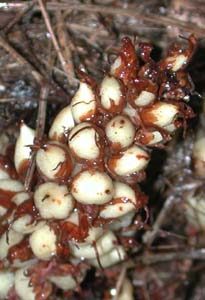
Squaw root in summer in flower at Awenda in July ,on the South Sparrow Lake Road.
 |
 |
Taken in the field at Awenda Park in November
 |
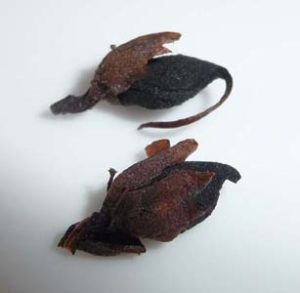 |
the seed pods, which are full of little brown seeds.
Other plants in the same family – Orobanchaceae- found in Ontario
|
Beechdrops (Epifagus virginiana) |
Orobanche uniflora (One-flowered Cancer-root) |
A totally different group without chlorophyll are the Monotropaceae. These are found in Ontario
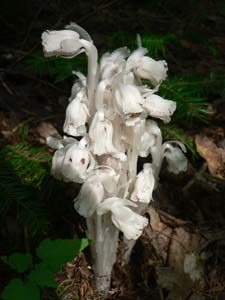 |
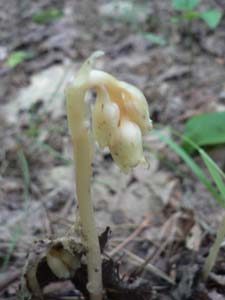 |
Squawroot, Beechdrops and One-flowered Cancer-root are not related to the other group of plants without chlorophyll – the Monotropaceae, which rely on fungal hosts for their carbon nutrition.
The Monotropa fools the fungus into thinking it is part of the mycelium, when it really is a parasite on the fungus, which is helping the plant gather nutrition from the soil.
Photos by Carol Strickland, Wendy Kirk, Nancy Ironside, and from the Margo Holt collection
October 2015 UHTHOFF TRAIL Enjoy the Signs and Benches
The 24 year old trail is well used by many: dog walkers, birdwatchers, hikers, bicyclists and horses. It is wheelchair accessible.
Now the trail welcomes other groups, who walk, but need to rest at times, or those who may just want to sit, surrounded by nature.
The Orillia Naturalists’ Club donated 11 benches ( 3 are replacements of broken benches) to the trail this October.
The trail has 2 sets of interpretive signs to raise our awareness of where we are, and why. Since 2003 there have been 3 signs at the Uhthoff Quarry. This year, in the spring, 3 signs were added near Matchedash Bay. (There is a bronze historical plaque at the entrance to the trail near Wilson’s Point Road.)
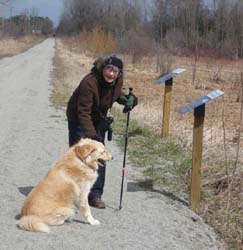

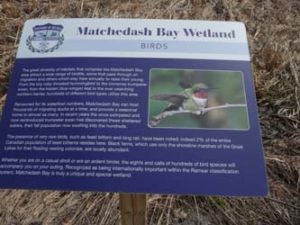

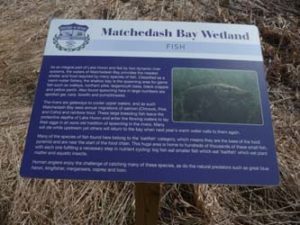
Pat Woodford is shown with the interpretive trail signs that were installed near Matchedash Bay, in the spring. They were designed by Dave Hawke and feature Fish, Birds and Habitat.
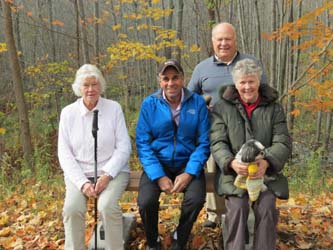 |
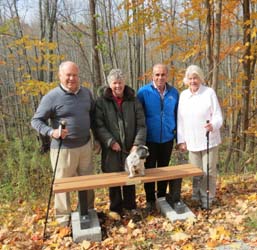 |
4 members of the Orillia Naturalists’ Club showed one of the benches to Severn Mayor Mike Burkett. Pictured with Mike, are Donald Macdonald, the club treasurer, Nancy Ironside, part of the original team who developed the trail, and Leanore Wianko with Chula, who are dedicated trail users.
This summer the Orillia Naturalists’ Club donated over $8000 for 11 new benches, which were added along the 30 km trail in October.
The Uhthoff Trail is a former CPR rail line, extending from the Lightfoot Trail in Orillia, past the Uhthoff Quarry, and on to Coldwater. The land was bought by the Orillia Township in 1988, and then leased to the Orillia Naturalists’ Club in 1991, to be managed as a recreational trail for the public. The original 9 kilometres was increased to 30 kilometres in 1998, when more land was purchased by the Township and the trail was extended to Coldwater.
In 2012 the trail was further extended from Coldwater to Tay Township.
In 2005 management of the trail was transferred from the Orillia Naturalists’ Club to Severn Township.
September 27, 2015 Super Harvest Blood Moon Total Eclipse
Seeing the moon on Sept 27 was challenging because of the intermittent cloud cover. Most people in Orillia had full cloud cover after 8:30, and so missed the eclipse entirely.
About a dozen people met in Carden and Arni was able to get the great pictures, shown below, when openings in the clouds occurred.
Ron and Sharon Hancock, in Oro-Medonte found an unexpected sudden break in the sky and were able to watch for about half an hour at 10 pm.
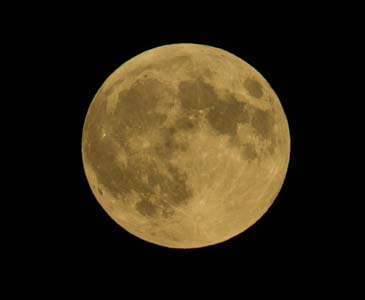
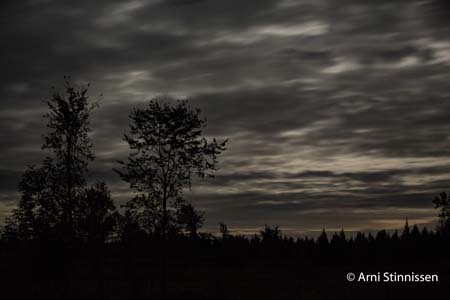

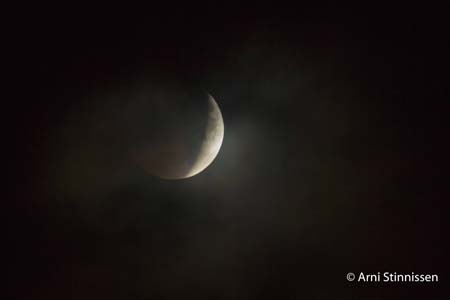


The plane of the orbit of the moon around the earth is offset by 5 degrees to the plane of the earth/sun orbit, which means that only once or twice a year is the earth, moon and sun aligned, and we need that alignment to have eclipses. A special eclipse of the moon occurred on Sept 27.
Not only was the moon in the shadow of the earth, but it was also closer to the earth at that time, making the moon appear 13% larger than normal. The moon’s orbit can vary 30000 miles in distance from the earth. The closest point to the earth is a called a perigee. Some call this moon a super moon. Most people will not notice the difference in size of the moon.
You must have a full moon to have an eclipse. This full moon is known as the Harvest moon, as it is the closest to the fall Equinox. So we had a full lunar eclipse on the Harvest moon.
As the moon turns reddish in the shadow of the earth it is sometimes called a blood moon. So this could be called a Super Harvest Blood Moon, of which there have only been five recorded since 1900. It will not happen again until 2033.
Text by Gord Michener
Photos by Arni Stinnissen
August 2015 Lobsters in the Forest Hypomyces lactifluorum
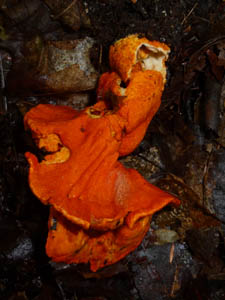
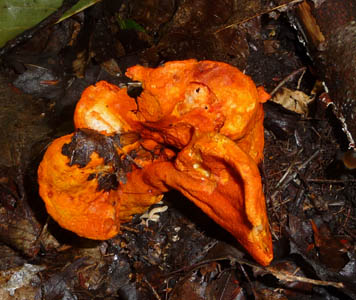

These spectacular fungi , commonly called Lobsters, have been found on several occasions this month, in mixed forests. This is a good example of a fungus growing on a fungus.
The red crust on the outside is the tissue of the ascomycete (Hypomyces),
and the white flesh on the inside is the flesh of a gilled mushroom, presumably a Russula or Lactarius. It is mycological cannibalism, (which is not unusual).
The host mushroom is usually Russula brevipes or, less often, Lactarius piperatus; healthy specimens of both were found nearby.
The Hypomyces does not attack all of the host specimens, since there must be some of the gilled mushrooms left to produce spores. That leaves something to parasitize next year. This is cannibalism, not genocide. This infection changes a benign but boring (taste wise) fungus into a gourmet’s delight.
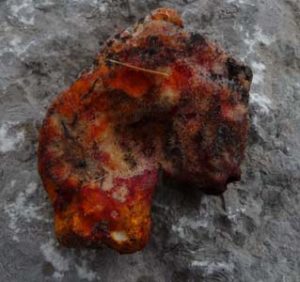
year for Lobster mushrooms, maybe
because it was
hot and relatively wet
This lobster was found Sept 19/15.
The parasite has been parasitized by at
least one more fungus, looking like
little white crystals
-part of the circle of life.
Interest is high in the edible wild, and late summer and fall is the season for foraging for wild mushrooms for dinner.
This should not be undertaken casually.
The Canadian Medical Association Journal published an article this month describing the treatment of a 54 year old woman, poisoned by Amanita bisporigera, who was treated at a hospital in Toronto, (probably last season).
She survived, but only because she was put on the urgent liver transplant list and was able to receive a liver in time.
Fulminant hepatic failure following ingestion of wild mushrooms
CMAJ August 11, 2015 187:822-824;
photos by Nancy Ironside and Sue Deadman
July 2015 The Sundew and the Damselfly
the Round-leaved Sundew (Drosera rotundifolia), and the Bluet (Enallagma sp).
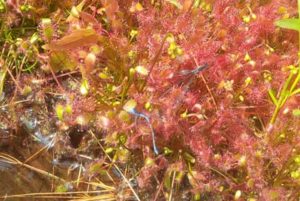 This photo was taken by Carolyn Paccagnella near Bala. |
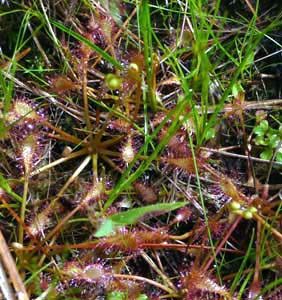 ( Couchiching Conservancy), near the Trent Canal. |
The Round-leaved Sundew, one of about 750 carnivorous plants, world-wide, is common in our area, but not often noticed.
They have stalked glands with tentacles, topped with sticky secretions, that cover their laminae. Sweet mucilage is secreted to attract and ensnare insects, and it also produces enzymes to digest them. The sessile glands absorb the resulting nutrient soup. The enzymes dissolve the insect and free the nutrients contained within it, which is then absorbed through the leaf surfaces to be used by the rest of the plant.
The tentacles are extremely sensitive and will bend toward the center of the leaf to bring the insect into contact with as many stalked glands as possible.
Since the Sundew thrives in wetlands such as marshes, fens and Sphagnum bogs, which are acidified and have poor nutrients, they must survive on captured insects.
Dragonflies and Damselflies are in the same insect order (Odonata), but damselflies are smaller and more delicate, the 4 wings are similar, and most Damselflies, when at rest, fold their wings against and above the abdomen.
Since Damselflies are weak fliers, they usually fly at low altitudes, where they can escape to the shelter of the vegetation, but this vegetation was not sheltering. Carolyn tried to “rescue” one, but it was already partly digested and did not move.
June 2015 Promethea Moth (Callosamia promethea) a member of the Saturniidae family of moths.
On June 17, Al Sinclair reported 3 Giant Silkworm Moths at his night light near Bracebridge ( Uffington)- cecropia, polyphemus, and luna.
June is their prime flight period.
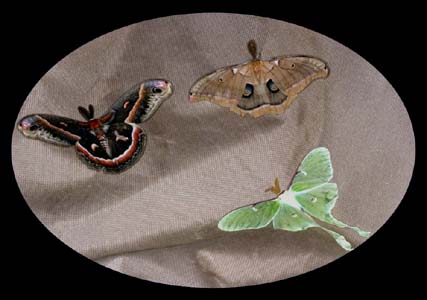
On June 28, Barbara Taylor wrote: Last week we noticed some Promethea Moth cocoons hanging from a small dead tree at the Bracebridge Ponds,
but the moths had already come out.
After searching nearby live cherry trees, we found a small group of eggs on the underside of the leaf, not far from the other empty cocoon.
On Friday, June 26, we found a second group of recently hatched eggs , and 6 tiny Promethea Moth larvae nearby.
I have put them in a protective cage to prevent parasitic wasps and tachinid flies from harming them.
The growing caterpillar’s appearance changes quite dramatically through the 5 instars.
The early instars stay together and line up in a row to feed on the same leaf.
|
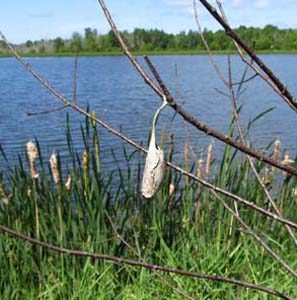 The cocoon hangs from the host plant throughout the winter. |
 Adults do not feed, so only live for a few days. They have no mouth parts or intestinal tracts -just mate. |
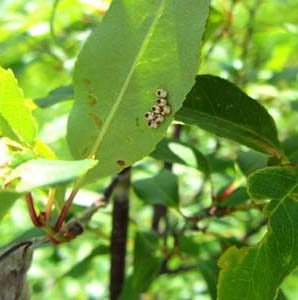 |
 An instar is a developmental stage; in order to grow, a caterpillar must shed its exoskeleton and each shedding results in another instar. |
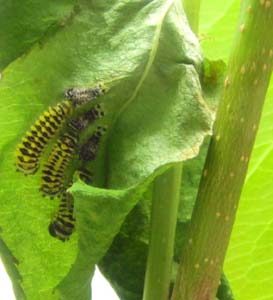 July 3 |
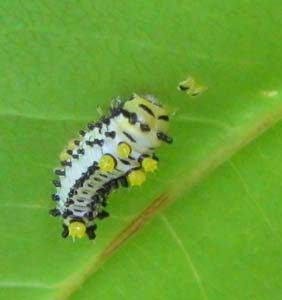 It hasn’t quite finished eating its old skin…you can see a tiny piece still attached to the leaf near its head. |
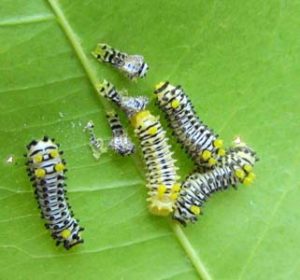 |
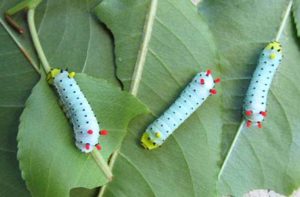 . They now have a greenish-white body without any black striping and the 4 “knobs” at the head end have changed from yellow to bright orange. |
Photos by Al Sinclair and Barbara Taylor of Muskoka.
Text is compiled.
May 2015 Louisiana Waterthrush
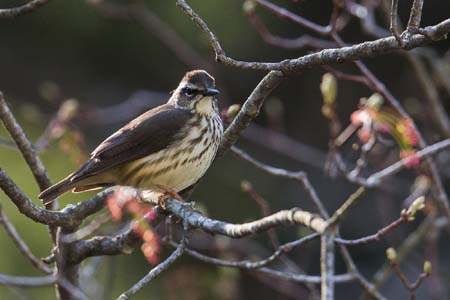 Also, the song, although similar to the Northern Waterthrush, is very different. Note the white eye line and bubble gum coloured legs. |
 |
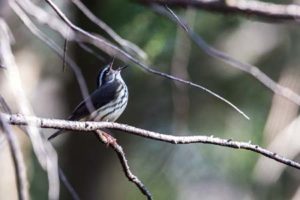 Several people reported that they saw 2 birds – ? a pair |
Peter Mills, who found the bird, writes:
“This warbler was among the first I saw at all this spring (April 28th).
I had found an advertising male in the same location in Copeland Forest last spring (May 12 2014), and purposefully strolled by the same rill and was very excited to find what is presumably the same bird again on territory.
After watching it for a few moments, a second bird (probably a female) flew into the scene.
The most recent Breeding Bird Atlas recorded this species as a breeder at this latitude but on the Niagara Escarpment, where more typical “Appalachian” streams are found. This record in Copeland Forest is unique because of its separation from the escarpment, and its otherwise rarity and distance from the core range farther south in Ontario and the United States.
The breeding habitat is a beautiful cascading rill in a shaded hemlock forest.”
Habitat photo and text from Peter Mills
Bird photos from Arni Stinnissen
April 2015 Purple Tiger Beetle Cicindela purpurea
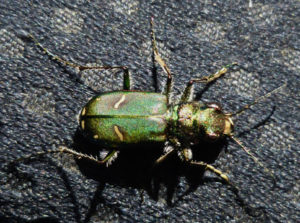 David Hawke reported that this beetle flew in his open car window while he was parked on Turnbull Ranch (Rohallion Road, a couple of kilometers
David Hawke reported that this beetle flew in his open car window while he was parked on Turnbull Ranch (Rohallion Road, a couple of kilometers
south of Kirkfield Road #6).
He reports that it was a very lively critter but willing to pose for a close up photo. Lucky Dave. They are hard to photograph, since they are famous
for their running speed. The fastest species of tiger beetle can run at a speed of 9 km/h (5.6 mph).
Dave saw his beetle on April 16. The Purple Tiger Beetle is active in the spring and fall.
Tiger beetles can be recognized by their huge eyes and large 3-toothed mandibles, crisscrossed at their tips, giving these hunters a bulgy- headed and toothy appearance. This species can be recognized by the two ‘slash’ marks on its back.
Tiger beetles kill their prey by banging their victims repeatedly on the ground, then chew them up and drink their juices.
If you find remains of mangled ants on bare ground, you may know they are in their burrows nearby, waiting for more prey.
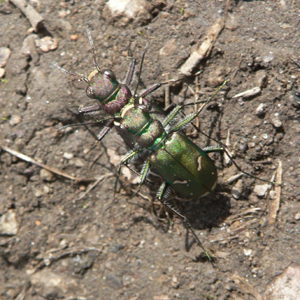 These mating purple tiger beetles were photographed on the 5th of April 2010 by Margo Holt, They would have spent the winter in the burrow, where they had pupated
These mating purple tiger beetles were photographed on the 5th of April 2010 by Margo Holt, They would have spent the winter in the burrow, where they had pupated
last fall, and so were able to emerge before most other insects.
Now the two-year life cycle begins again.
Tiger beetle burrows might seem nothing more than a simple hole in the ground – anything could have made it. The largest tiger beetle burrows are most often observed at 3rd instar, since it is this final instar in which the larva spends the majority of its time and the burrow becomes most noticeable.
The larvae make round straight burrows, usually in bare soil. The edges of the burrow’s mouth are smooth and rounded, and the adjacent ground surface is cleared free of excavated earth. Each of the three instars make successively larger holes.
When hunting the larva plugs the entrance, with its disc shaped head springing like a jack-in-the-box to grab ants or
other insects that come near. A pair of stout hooks on the back hump prevents the larva from coming all the way out. The adult tiger beetles dig short sloping burrows, in which they hide in stormy or cold weather, as well as at night. Like the larva the adults excavate deep tunnels for overwintering. According to reports, they have a 2 year life cycle
The challenge now is to find and photograph the burrows – or are you looking at and studying a simple hole in the ground?
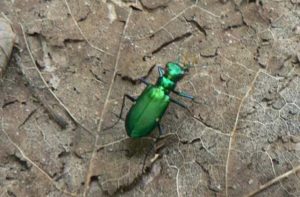 There are 14 species of tiger beetles in Ontario.
There are 14 species of tiger beetles in Ontario.
The most familiar tiger beetle is the metallic green species,
Cicindela sexguttata –the Six-spotted Tiger Beetle.
(The number of spots can vary.)
As with other Tiger Beetles, it usually appears in the spring,
having spent the winter as an adult, hidden in the same burrow
it had pupated in the previous fall.
Photo taken by Margo in June 2010
Text based mainly on INSECTS, by Stephen Marshall, and
TRACKS AND SIGNS OF INSECTS, by Eiseman and Charney.
For identification see: Tiger beetles of Ontario by Steve Marshall on the web.
March 2015 Northern Lights

With a combination of solar weather forecasting and Dark Sky Reserves like the one at the Torrance Barrens, north of Orillia, dedicated observers can determine the best nights to catch a glimpse of the northern lights.
On occasion, when the conditions are just right, even the casual observer has the opportunity to see the northern lights.
Such was the case this March when the skies were alight with the vibrant colours of the northern lights.
Northern lights, or Aurora borealis as they are known in the northern hemisphere or Aurora australis in the southern hemisphere are a celestial wonder. The temperature above the surface of the sun
is millions of degrees Celsius. At this temperature, collisions between gas molecules are frequent and explosive. Free electrons and protons are thrown from the sun’s atmosphere by the rotation of the sun
(think of a spraying garden hose), and escape through holes in the magnetic field.
Blown towards the Earth by solar winds, the charged particles are largely deflected by the Earth’s magnetic field. However, the Earth’s magnetic field is weaker at both poles and some particles enter the Earth’s atmosphere
and collide with gas particles. These collisions emit the light we can observe dancing in the sky.
Variation in the colour of the visible lights is due to the type of gas particles that are colliding. Most common are green and pink hues dancing in the sky, but sometimes also red, blue and purple shades.
Oxygen gives off a green colour, while higher nitrogen levels causes blue or red.
Travelling 150 million kilometers in 3-5 days, these gusts of charged solar particles are more readily seen closer to the earth’s magnetic poles, but sometimes can be seen as far south as the southern United States.
Solar forecasters are able to track sun spot activity and are able to predict more accurately when to expect a vibrant display.
The best location to view the auroras is likely from space, however that isn’t achievable for many of us, so the next best thing is in the darkest sky possible, between 11:00 pm -3:00 am from about August to April.
If you’re not one to hike into the wilderness in the middle of the night, you are now able to live stream northern lights being recorded in the north from the comfort of your living room.
Text by Kyra Howes. Permission to use the photo was obtained from Lee Mann.
February 2015 Bald-faced Hornets (Family Vespidae Dolichovespula maculata)
make large paper nests in trees, are common, and are part of the balance in nature.
|
In August 2014, in the backlands of Matchedash, a fallen nest was found near the trail. |
 |
detail of the beautiful pattern paper-like material |
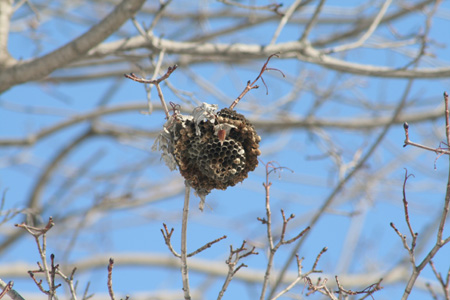 |
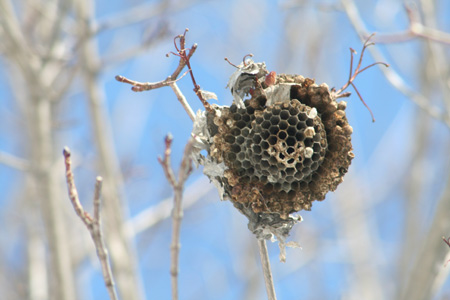 |
This month the remains of a nest were found in a maple tree, about 6 metres from the ground, between the Lightfoot trail
and Bay St. on Borland St. in Orillia.
Social wasps survive the winter only as mated queens, which start colonies the next spring. In the summer the worker wasps forage for insects, and insert them into the hexagonal cells in the nest combs. The colony continues to grow and enlarge the nest. Following the arrival of cold weather, all the hornets but the queen die, and the nest falls into disrepair. Overwintering queens are tolerant of ice formation in their body fluids down to temperatures of approximately – 14°C.
They often burrow into an old tree stump to survive the cold.
Contributing to this frost tolerance is a high concentration of the cryoprotectant glycerol which prevents lethal intracellular ice formation. An additional factor is the presence in the hemolymph of macromolecular ice nucleating agents – very important factors for survival, especially this winter here in Orillia. In the spring she will build a small nest, lay a few eggs, and this brood will be the workers, while she continues to lay more eggs to rebuild the colony.
W.D. and Irene McIlveen did a study of Bald-faced Hornets in Dalton County, each fall from 1991 to 2004, documenting the occurrence of wasp nests, after the leaves fell from the trees when they were easily visible. In all they found 240 nests mostly along the roadways, (possibly because they were the routes most travelled).
They assumed that all nests had been active in the current year.
Nests were seldom found in conifer trees. The hornets preferred maple trees especially sugar maples, (possibly for the queen to feed on the sap in the spring), not too distant from a source of water, and
a dry and relatively sunny exposure. They found the nest is usually about 7-9 metres above ground.
They published their findings in Ontario Insects, the News Journal of the Toronto Entomologist’ Association in January 2015,
and this is a very condensed summary. Since studies, such as the McIlveen’s, are rarely done, it would be hard to document a change in the hornet’s abundance.
Would we care? We should care.
Photos by Donald Macdonald
Overwintering Varied Thrush January 2015
This beautiful bird is a common summer resident in the mountains and to a less extent in the lowlands along the west coast
from Alaska to Oregon. It feeds mainly on insects and berries.
The thrush usually migrates as far south as California, in flocks, but they overwinter -rarely- across North America,
as solitary birds, usually associated with a feeder, even as far away as southern Newfoundland and into northern Mexico
We have records of 3 sightings in the Orillia area.
One arrived on Bay Street on January 15,1995 and was last seen March 27. Although there was little snow cover that year, we still babied and
fussed and worried over our bird all winter. When we first heard its clear call from the top of a tall tree on March 16, we were happy to
know that it had survived and that he was happy too. Then he left.
The next sighting was at Big Cedar Estates, the winter of 2005.
The one photographed here is in Bass Lake Woodlands, and was first seen in November 2014, and remains into 2015, feeding in the open several
times a day. It was last seen on April 9.
All 3 birds found shelter by Cedar hedges, where they maybe able to supplement their bird seed diets with insects.
Lucky the feeder owner who is chosen by this showy bird.
